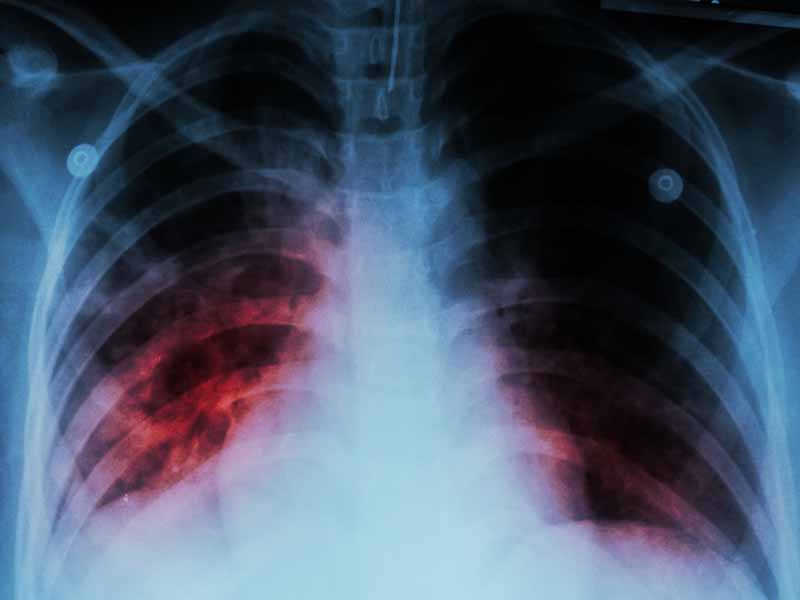CDC Updates Latent TB Infection Treatment Recommendations
July 06, 2018, 04:12 pm News Staff – The CDC has updated its 2011 recommendations for use of once-weekly isoniazid and rifapentine (Priftin) for 12 weeks (3HP) to treat latent TB infection (LTBI).
Published June 29 in the agency's Morbidity and Mortality Weekly Report (MMWR), the recommendations support and expand the use of a shorter, yet still effective, treatment regimen to reach even more patients with LTBI.
"Treatment of latent TB infection is essential to controlling and eliminating TB in the United States because it substantially reduces the risk that latent TB infection will progress to TB disease," the agency said.
The CDC went on to say that short-course treatment regimens, such as 3HP, are preferred because of their relative convenience, which likely leads to higher rates of treatment completion.
New Recommendations

Based on evidence of effectiveness, safety and treatment completion rates from a systematic literature review, and after considering viewpoints from TB subject matter experts and input from the HHS' Advisory Council for the Elimination of Tuberculosis and the public, the agency continues to recommend 3HP to treat LTBI in adults.
Additionally, the agency now recommends use of 3HP
- in patients ages 2-17 years who have LTBI;
- in patients with LTBI who also have HIV infection, including AIDS, and who are taking antiretroviral medications with acceptable drug-drug interactions with rifapentine; and
- by directly observed therapy (DOT) or self-administered therapy (SAT) in patients age 2 or older.
"The health care provider should choose the mode of administration (DOT versus SAT) based on local practice, individual patient attributes and preferences, and other considerations, including risk for progression to severe forms of TB disease," the MMWR article advised.
And when treating patients with HIV infection, "Use of concomitant LTBI treatment and antiretroviral agents should be guided by clinicians experienced in the management of both conditions," the article noted.
Story Highlights
Systematic Review
The CDC reviewed 292 citations on this topic, with 30 full-text articles screened for inclusion. No eligible studies included children younger than age 2. The CDC's meta-analysis ended up reviewing 19 articles that represented 15 unique studies.
The agency said findings from the meta-analysis indicated that 3HP was as safe and effective as other recommended LTBI therapeutic regimens and achieved significantly higher treatment completion rates.
One of the recently published randomized controlled trials that was heavily weighted in the meta-analyses and drug interaction studies was a large trial of 3HP administered by DOT that included children ages 2-17 and showed 3HP was as well-tolerated and effective as nine months of daily isoniazid (9H) for preventing TB.
This trial also reported that 3HP was safe and had higher treatment completion rates than 9H. Data on the safety and pharmacokinetics of rifapentine in children younger than age 2 were not available.
In 2011, the CDC recommended that patients with HIV/AIDS receive the 3HP regimen to treat LTBI if they were otherwise healthy and not taking antiretroviral medications.
"Since that time, additional data confirm not only the effectiveness of 3HP in persons with HIV infection who are not taking antiretroviral therapy, but also demonstrate the absence of clinically significant drug interactions between once-weekly rifapentine and either efavirenz (Sustiva) or raltegravir (Isentress) in persons with HIV infection who are treated with those antiretroviral medications," said the agency in its MMWR.
Finally, a randomized clinical trial that demonstrated non-inferior treatment completion and safety of 3HP-SAT compared to 3HOP-DOT in patients ages 18 and older provided the primary evidence to support 3HP administration by SAT.
It should be noted that the 3HP-SAT regimen has not been studied in randomized controlled trials of patients younger than 18.
Expert Consultation
In addition to performing a systematic review, the CDC researchers also met with nine external subject matter experts in TB and LTBI diagnosis, treatment, prevention, surveillance, epidemiology, clinical research, pulmonology, pediatrics, HIV/AIDS, public health programs and patient advocacy.
The CDC presented its systematic review results and proposed recommendations to the experts, who provided
- individual perspectives on the review,
- experience with implementation of the 3HP regimen in various settings and populations, and
- individual viewpoints on the proposed updates.
Subject matter experts from programs prescribing 3HP described the benefits of this regimen, including increased acceptance and better treatment completion rates.
"Some experts reported that several health departments are currently using 3HP, with high treatment completion, in children as young as age 2," the MMWR said. "Some noted that the 2011 recommendation to administer 3HP by DOT limits use of the regimen."
Finally, in December 2017, the agency sought input from HHS' TB advisory council and from members of the public to incorporate into its final recommendations.
Available Resources
The CDC has created downloadable resources on using 3HP to treat LTBI to complement its published recommendations.
For health care professionals, the agency created an FAQ document and a clinical fact sheet.
For patients, the CDC crafted a patient information brochure, along with a medication tracker and symptom checklist.
More From AAFP
Clinical Preventive Services Recommendation: Tuberculosis Infection, Asymptomatic Adults